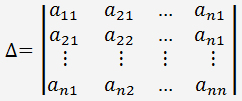Solving a system of linear equations using Cramer's rule
Cramer's rule may only be applied for a system of linear equations with as many equations as unknowns (the coefficient matrix of the system must be square) and with non-zero determinant of the coefficient matrix.
Consider a system of n linear equations for n unknowns x
1, x
2, ..., x
n:
a
11x
1 + a
12x
2 + ...+ a
1nx
n = b
1
a
21x
1 + a
22x
2 + ...+ a
2nx
n = b
2
... ... ... ... ...
a
n1x
1 + a
n2x
2 + ...+ a
nnx
n = b
n
The determinant of the coefficient matrix

Let

be the determinant of the matrix formed by replacing the j column with the column of the constant terms

If

, the system has a unique solution

Since the computation of large determinants is cumbersome, Cramer's rule is generally used for systems of two and three equations.

 be the determinant of the matrix formed by replacing the j column with the column of the constant terms
be the determinant of the matrix formed by replacing the j column with the column of the constant terms 
 , the system has a unique solution
, the system has a unique solution
